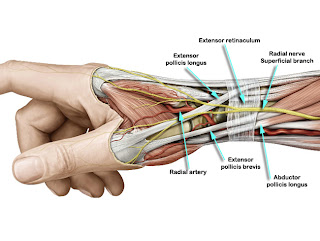Heel pain: Usual & unusual causes
Introduction:
Planter heel pain & posterior heel pain: Plantar heel pain is a symptom commonly encountered by clinicians. A variety of soft tissue, osseous, and systemic disorders can cause heel pain. Tendonitis also may cause heel pain. Achilles tendonitis is associated with posterior heel pain. Bursae adjacent to the Achilles tendon insertion may become inflamed and cause pain.
HPT (heel pain triad): Labib et al described the heel pain triad (HPT). HPT is a combination of plantar fasciitis, posterior tibial tendon dysfunction and tarsal tunnel syndrome.
They hypothesized that failure of the static (plantar fascia) and dynamic (posterior tibial tendon) support of the longitudinal arch of the foot has resulted in traction injury to the posterior tibial nerve, i.e., tarsal tunnel syndrome.
When such a situation is present then all abnormalities i.e. plantar fasciitis, posterior tibial tendon dysfunction and tarsal tunnel syndrome must be recognized and treated.
Classification of planter heel pain: Planter heel pain can be sub-divided in to neural & non-neural pain. The non-neural pain can again be sub-divided into 2 bony & soft tissue pains.
Neural pain: Injury to the tibial nerve and its branches in the tarsal tunnel and in the foot is also a common cause. Entrapment of these nerves may play a role in both the early phases of plantar heel pain and recalcitrant cases (2). Patients with plantar heel pain accompanied by tingling, burning, or numbness may have tarsal tunnel syndrome (4).
Non-neural pain (bony pain): calcaneal fracture. Calcaneal stress fractures are more likely to occur in athletes who participate in sports that require running and jumping (4).
Non-neural pain (soft tissue pain): Several conditions such as plantar fasciitis, rupture of the plantar fascia and atrophy of the heel fat pad may lead to plantar heel pain (2). Heel pad atrophy may present with diffuse plantar heel pain, especially in patients who are older and obese (4).
Plantar fascia lesions: The most common cause of heel pain in adults is plantar fasciitis. Patients with plantar fasciitis report increased heel pain with their first steps in the morning or when they stand up after prolonged sitting (4). Lesions of the plantar fascia form an important group. Common lesions of the plantar fascia include plantar fasciitis, plantar fascia rupture, plantar fibromatosis, and plantar xanthoma etc. Many times the planter fascia pain may arise from foreign-body reactions, enthesopathy, and diabetic fascial disease (3).
Few common clinical diagnostic clues to 2 most common conditions
The dorsiflexion-eversion test is used to diagnose tarsal tunnel syndrome (TTS), whereas the windlass test (dorsiflexion and eversion of the ankle in combination with extension of the metatarsophalangeal) is used for plantar fasciitis. Both tests mechanically challenge various structures that have been associated with plantar heel pain. However the usefulness in differential diagnosis in planter heel pain remains a question (4,5).
Unusual cause of heel pain:
Less common causes of heel pain, which should be considered when symptoms are prolonged or unexplained, include osteomyelitis, bony abnormalities (such as calcaneal stress fracture), or tumor. Heel pain rarely is a presenting symptom in patients with systemic illnesses, but the latter may be a factor in persons with bilateral heel pain, pain in other joints, or known inflammatory arthritis conditions (4).
Deep-seated neurilemmomas in the foot can easily be overlooked and misdiagnosed as tarsal tunnel syndrome or plantar fasciitis because of the rarity, absence of palpable mass, and similarity of symptoms to those of other frequently encountered foot disorders. Marui et al reported neurilemmoma in the foot as a cause of heel pain. neurilemmoma that arose from plantar branches of the posterior tibial nerve and caused chronic heel pain. These cases are misdiagnosed as tarsal tunnel syndrome or plantar fasciitis. These cases are appropriately treated by surgery (6).
References:
1. Labib SA et al; Foot Ankle Int. 2002 Mar;23(3):212-20.
2. Alshami AM et al; Man Ther. 2008 May;13(2):103-11. Epub 2007 Mar 30.
3. Jeswani T et al; Clin Radiol. 2009 Sep;64(9):931-9. Epub 2009 Jun 18.
4. Aldridge T; Am Fam Physician. 2004 Jul 15;70(2):332-8.
5. Alshami AM et al; Foot Ankle Int. 2007 Apr;28(4):499-505.
6. Marui T et al; Foot Ankle Int. 2004 Feb;25(2):107-11.


Comments
Post a Comment